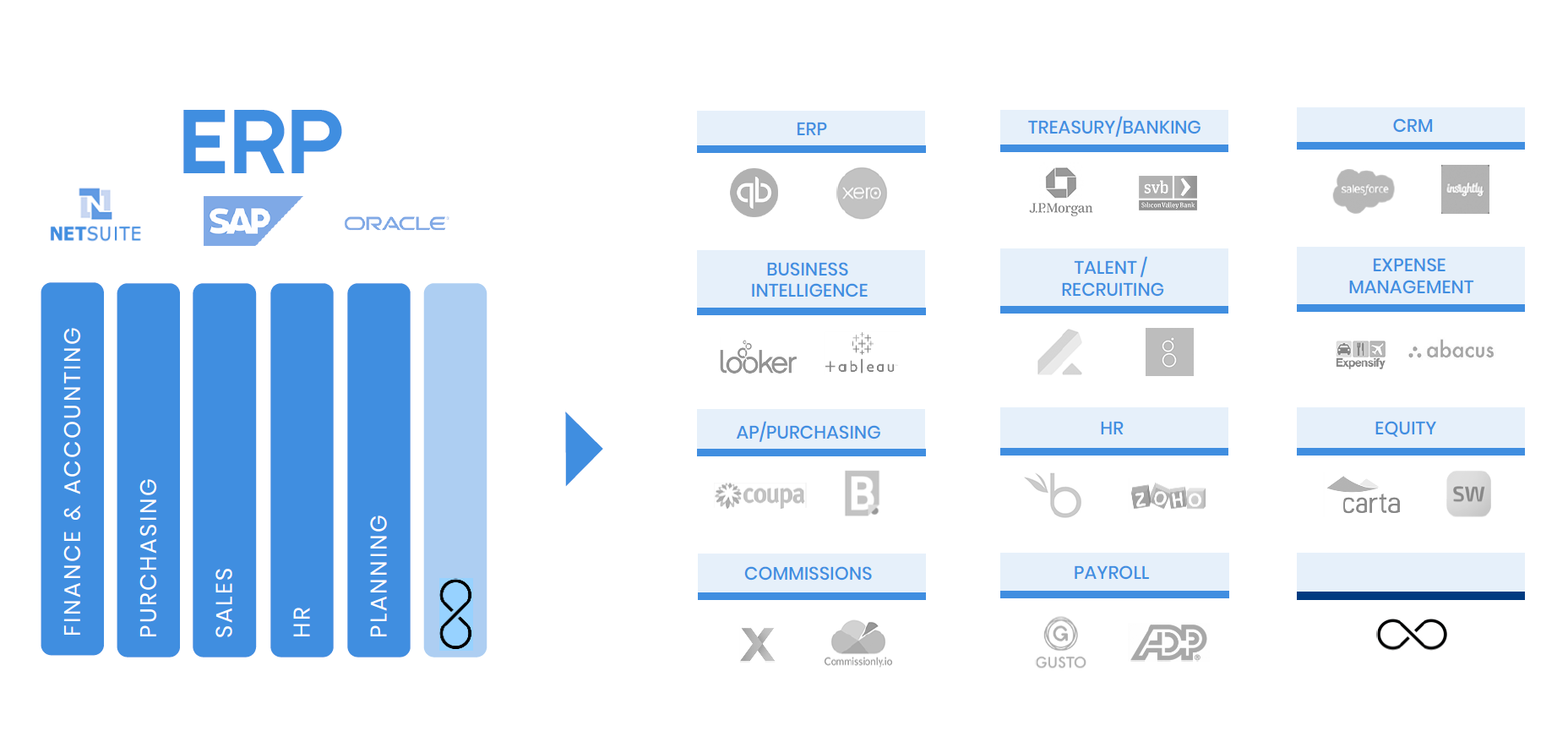Re-Bundling Finance—Former NetSuite CFO on How Scaling Has Evolved

Joe Garafalo
Founder and COO
As former CEO of Netscape Jim Barksdale once said, as a business “you are always bundling and unbundling.” Microsoft is the perfect example. They cornered the market on business productivity tools by bundling Word, Excel, and PowerPoint into the Office suite. And now, competitors like Notion, Airtable, Figma, and Front are unbundling Office by focusing on individual pieces of the larger platform.
But the cycle of bundling and unbundling doesn’t only apply to big-picture market shifts. Internally, finance functions have been following a similar cycle. We talked to former NetSuite CFO Ron Gill about how the process of bundling and unbundling has affected finance.
While there are benefits to the unbundling of finance in the SaaS era, one thing seems clear: if you want to scale effectively, you need to re-bundle the strategic finance function.
Bundling Was the Best Way to Scale Finance (Until It Wasn’t)
In the mid-1990s before the rise of the internet, companies often had several finance teams dedicated to serving specific business units, product lines, and locations. Before Ron was CFO at NetSuite, he served as VP for SAP. At SAP, Ron described the finance function as having “subsidiaries in dozens and dozens of countries, and essentially a full finance function in each country.”
That included a full tech stack for accounts receivable, accounts payable, billing, and other operational functions that varied by team and location. According to Gill, that was just “the way companies used to grow up.”
With each team having their own unique tools and processes, consolidating insights for a holistic picture of the business was an extremely difficult, time consuming task. The worst part? It was ripe for manual errors.
“The CFO will feel some pressure to keep costs down, but they get fired if the numbers are wrong.”
As the internet took flight, the need for bundling in finance became painfully obvious. Centralizing financial operations in one place made it easier for CFOs and controllers to oversee their teams and track numbers compared to when finance was distributed across dozens or even hundreds of countries.
One benefit of going through the tough, painful shift from decentralized to centralized finance? Significant time and cost savings. But bundling finance into a central office wasn’t just about cutting costs—it was about building the function in a way that gave CFOs and controllers the greatest control of their numbers.
According to Gill, “the CFO will feel some pressure to keep costs down, but they get fired if the numbers are wrong.” And that’s why centralizing finance was so valuable. The transition gave CFOs a way oversee operations more closely to improve the integrity and repeatability of financial processes.
ENTER THE ERP.
In the 2000s, SaaS ERP vendors like NetSuite began to offer mission-critical software platforms that promised to be the perfect solution for bundling modern finance.
Having one system like an ERP to house all customer and financial data across the globe should have been the simplest way to run a business and consolidate insights, and it was. For the past two decades, the ERP has been a dominant force in the space. It has been more than mission-critical; it’s daily-business critical.
But as SaaS began to eat everything ERPs have begun to unravel, and as with all things cyclical, we’re seeing the cycle of bundling and unbundling play out again, this time in a different way.
Business and finance users have been attracted to SaaS tools that offer lightweight, low-cost, highly flexible point solutions with robust features. As Gill put it, “point solutions often solve narrow problems better than the ERP suite, but usually at the cost of the ERP’s integrated processes and unified data model. SaaS delivery has made it much easier for companies to put dozens of different point solutions in place, each with its own process and data model.”

The SaaS delivery model leads to fragmented customer records that hurt data integrity across an organization. According to Gill:
Implementation took so long and cost so much in the days of client-server ERP that it was difficult to realize the dream of a single, unified customer record. SaaS architecture made it easier to get that single ERP system implemented company-wide. But it opened the door for every process owner to put in a point solution that was perfect for their narrow area of the business, to the detriment of the larger process and data integrity.
The ERP system remains a core component of any modern finance function. It just doesn’t drive the scaling process now that SaaS tools have taken over.
Unbundling Has Made Scaling Finance More Complicated
The explosion of point solutions has unbundled the finance function, spreading operations and data across many different systems making it harder to maintain control of your numbers at scale.
The finance function itself isn’t spread across hundreds of countries like it was in the 1980s and early 1990s. But financial data is fractured nonetheless. When financial operations span 50+ systems, it can seem almost impossible to piece all the data together and make sure you can trust your numbers quarter after quarter. According to Gill, the problem is that no one has focused on how all those systems actually tie together:
You get to a point where you might have three systems that can all execute the same process. But you still end up running the process through Excel spreadsheets because none of the data you need exists in those powerful point solutions. When no one focuses on implementing the point solutions in a way that ensures they can all work together, you end up with inefficiencies that put financial operations at risk.
In theory, SaaS solutions that help automate operations should make it easier to scale the finance function. But while SaaS tools make life easier for some individuals in an organization, they make it more difficult to maintain data integrity across an organization.
Solving data integrity and governance problems doesn’t mean leaving SaaS tools behind and hoping an ERP can be the one platform to manage the entire business and its functions. However, there needs to be a better way to bring all of those SaaS tools together.
It’s Time to Re-Bundle Finance in a Modern Way
The best way to scale modern finance is to re-bundle the function without taking away the power and flexibility of point solutions. Finance leaders need to make sure there’s an overlay in place to govern business processes—one that can maintain data integrity across the many systems that now impact financial operations.
During Gill’s time at SAP and NetSuite, IT was responsible for approving system implementation and creating this overlay. They brought “intentional architectural design to the scaling finance function with a clear understanding of how different systems and data would connect.”
Now, finance needs to get back to intentional architecture even as individual business users are making purchase decisions. But too often, business intelligence (BI) becomes the solution to this challenge—and it isn’t quite right for the job. Gill said:
Business intelligence is a great way to create a single source of truth for financial data that lives in all your different point solutions. But it can’t fix process issues. It doesn’t get your data to move smoothly through an end-to-end process. Now, finance needs a solution like Mosaic that doesn’t just pull and visualize the data, but also runs core processes like planning, mapping, reporting, and modeling.
Scaling modern finance requires a broad process mindset. We don’t need to go back to the days of central IT teams making all the decisions about financial system implementation. But Gill said that finding a “happy medium that’s 10% of the way back there” is crucial for scaling finance. And that means adding the right technology that enables financial business intelligence and creates a connective tissue that goes beyond point solutions like NetSuite report builder to re-bundle the finance function and maximize data integrity.
Take Advantage of the Opportunity to Scale Finance Sooner
Scaling finance used to be something that companies only started to worry about when they were considering an IPO. Until that point, they’d keep finance as lean as possible while focusing entirely on product and the go-to-market motion. And so, no one would think about re-bundling all the SaaS tools creating financial exhaust until the last possible moment. But times are changing.
When Gill was at SAP and NetSuite, scaling finance almost always meant hiring more people. Now, there are more opportunities to add relatively inexpensive tools and get more done with fewer people. “I see these tools going in earlier and earlier to help finance scale,” said Gill. “And the good news is that if you have machine-oriented processes, it’s easier to scale to the next step as well.”
The SaaS tools that have made it harder for finance to scale effectively are the same tools that can help you scale faster. That’s why a broad process mindset is so crucial—it’s the key to staying in control of all those SaaS tools that generate financial data.
The earlier you focus on re-bundling finance, the easier it will be to scale later. This is an opportunity that, as Gill says, “just didn’t exist 10 years ago.” Take advantage.
Own the of your business.
